What Hi-Fi? Verdict
The Progression Integrated delivers the performance you’d expect from, say, the equivalent model in D’Agostino’s Momentum series, at a fraction of the price. It’s everything you need in a high-end audio amplifier.
Pros
- +
World-class amplification
- +
Versatility of options
- +
Love those needles!
Cons
- -
Only price!
Why you can trust What Hi-Fi?

This review and test originally appeared in Australian Hi-Fi's special edition Audio Esoterica magazine, one of What Hi-Fi?’s sister titles from Down Under. Click here for more information about Australian Hi-Fi, including links to buy individual digital editions and details on how to subscribe. Read What Hi-Fi?'s global, star-rated Dan D'Agostino Progression Integrated review.
The Progression Integrated amplifier offers everything you need in a high-end audio amplifier. Of course you might hope for that, given that the fully optioned version that we review here will set you back AU$47,985 (£26,250, $25,000), a price which is comprised of AU$34,995 (£18,500, $18,000) for the base analogue model, plus AU$8995 (£5500, $5000) for the DAC module, and AU$3995 (£2250, $2000) for the phono module.
So what allows this slightly steam-punk needle-laden design to command such rarefied pricing?
Master at work
Daniel D’Agostino, the founder of D’Agostino Master Audio Systems and the designer of the Progression Integrated amplifier, is one of the world’s foremost amplifier designers. He first found fame as the founder of Krell, where his amplifiers were lauded for their power, their performance and their sound quality. As for their looks, well, not so much, as Borat would say.
When Daniel founded D’Agostino Master Audio Systems, he decided that he’d better begin to start paying as much attention to his amplifiers’ external appearance as he did to their circuitry, their performance and their sound quality. His first design, the Momentum M400 mono power amp, was arguably the first amplifier he’d ever designed that looked every bit as good as it sounded, which was proved by its sales success, despite its price (which is in “if you have to ask” territory, but is still considerably less than that of his current flagship mono amplifier, the Relentless).
But its success was what spurred D’Agostino to continue in the same design vein, and whose looks and circuitry influenced his ‘budget’-priced Progression Series, which currently comprises the integrated amplifier under review, a monobloc power amplifier, a stereo power amplifier and a pre-amplifier.
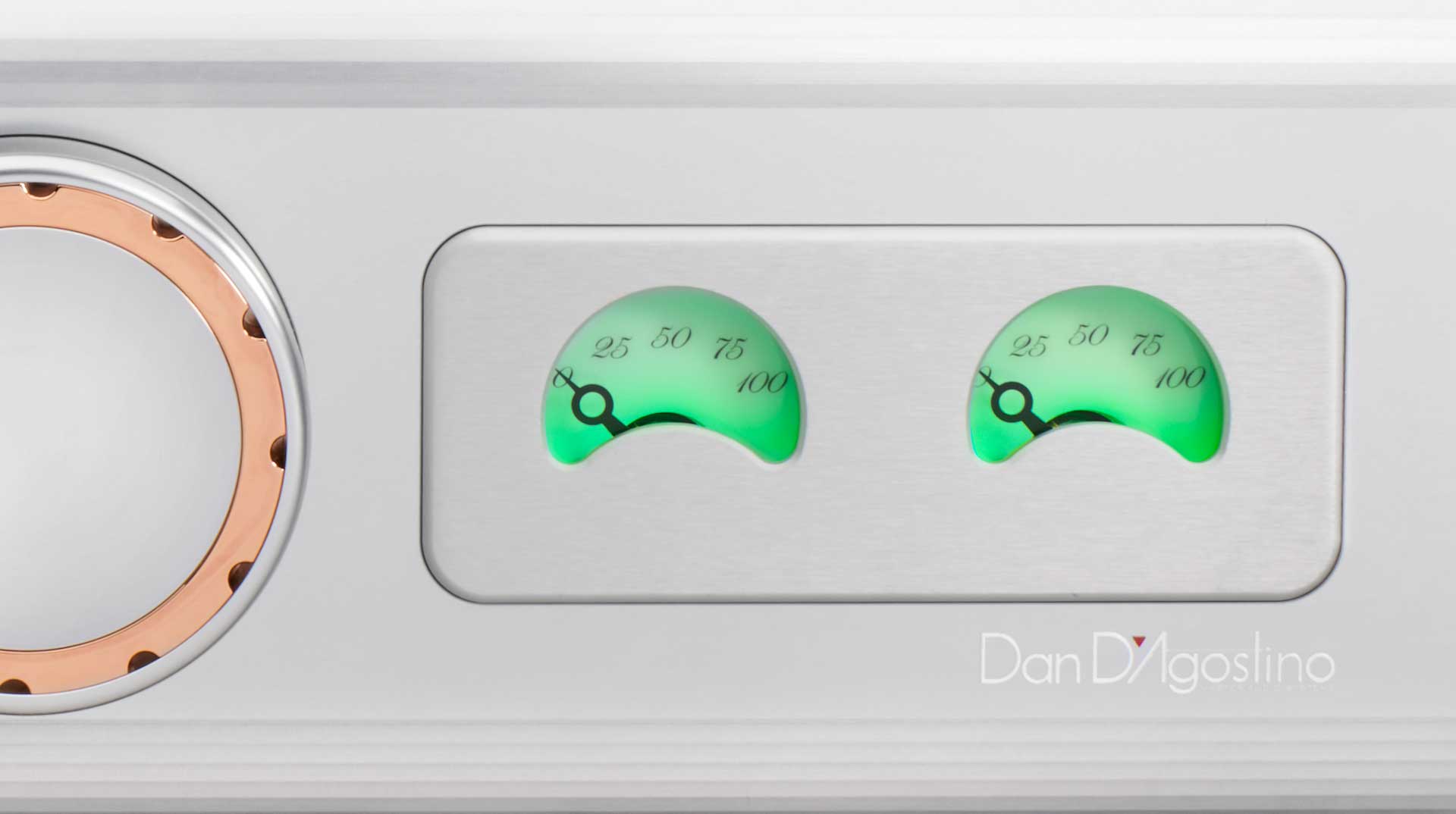
Build & design

Power Output (8Ω): 200 watts per channel
Power Output (4Ω): 400 watts per channel
Frequency Response: 0.1Hz to 1MHz, –3dB
Frequency Response: 20Hz to 80kHz, ±0.5dB
Total Harmonic Distortion (@ rated output): <0.1%
Signal-to-Noise Ratio: 95dB (unweighted)
Standby Power Consumption: 14 watts
Input Impedance: 100kΩ
Output Impedance: 0.1Ω
Dimensions (HWD): 178×432×432mm
Weight: 26kg
One of the features of all amplifiers bearing D’Agostino’s name has been the presence on the front panel of one or more multi-function meters whose appearance resembles that of an expensive Patek Philippe chronograph (or time-piece if you prefer, but I can’t bring myself to call it a wrist-watch).
While this marketing device has been remarkably successful at carving out an identity for the brand, these meters have polarised the opinions of critics. One result of this diversity of opinion is that with each new design, D’Agostino has made the meters a little less ostentatious, reducing the size of the meters themselves, the size of the bezels surrounding them and the distance they protrude from the front panel, so that the Progression pre-amplifier was the first time the meters were contained completely within the front panel, though still surrounded by a coppery bezel.
The latest hi-fi, home cinema and tech news, reviews, buying advice and deals, direct to your inbox.
As you can see, D’Agostino has gone even further with the Progression integrated and removed the individual bezels completely and replaced them with a single rectangular surround that mirrors the one on the opposite end of the front panel that contains the buttons (all of which have inbuilt LEDs) that are used to select whichever input you’d like to be active. Speaking personally, I would have preferred it if Daniel had used the same meters on the Progression Integrated as he used on the preamplifier. My advice to him would be: “Don’t listen to the critics any more.” (But if he listened to that, he’d be ignoring the advice I just gave him.)
Although he can tinker with the appearance of the meters, D’Agostino can’t eliminate them completely, because as I stated earlier, they’re multi-function meters, not just standard ‘power output’ meters – in fact they’re not actually ‘power output’ meters at all. During normal playback, the meters function as ‘signal level’ meters, indicating the average signal level of the music being played.
However, if you want to adjust channel balance (and the Progression Integrated is one of the very few modern high-end amplifiers that will allow you to do this), the meters become indicators of channel balance. And whenever you adjust the volume control, the meters indicate the volume level you have selected. These function changes happen completely automatically, which is rather clever.
In another nod to the critics, D’Agostino has included a ‘Dark’ mode on the Progression Integrated that if activated will cause the front panel of the amplifier to be completely dark: no glowing LEDs, and no greenish meter illumination. Adjusting a front panel control (or one on the remote control) will deactivate the ‘Dark’ mode for around 15 seconds so you can see the result of what you’ve done, but after that the illumination will again extinguish.
Another reason for using D’Agostino’s ‘Dark’ mode would be if you have switched the amplifier’s ‘Mute’ control on (only available from the remote control), and most particularly if you have switched the polarity of the signal (also only available from the remote control) before using the Mute control. This is because when the Mute control is activated in normal mode, the two front panel meters flash green then white, then green continuously, at about two flashes per second. If the polarity of the amplifier has been inverted, the meters flash red, then white.
Although it’s fairly common for DACs and CD players to provide push-button access to signal polarity inversion, it’s rare to find it on an amplifier. Which kind of begs the question of why you’d want to be able to invert signal polarity at all. It’s all to do with maintaining the acoustic integrity of the original performance.
Consider that when a drummer pushes the pedal that operates his (or her) kick-drum, the beater hits the drum skin, forcing it to go forwards, compressing the air in front of it, after which it moves backwards, then forwards and so on until the vibration dies. But the initial movement was forward, into the room.
If the sound of that kick drum is recorded, and signal polarity is maintained through-out the recording and playback chain, when your speakers replay that sound, the woofer’s movement should be the same as the original drum skin, in that it should first move outwards into the room. However, if signal polarity is inverted due to errors in the recording/reproduction chain, your woofers will move backwards instead of forward at the initial ‘hit’.
The above simplification makes it easy to see the initial problem. But there’s a further problem, which is that it’s actually impossible to know whether a signal that’s going into the Progression amplifier is the correct polarity in the first place so, in the exact words of D’Appolito’s Owners Manual: “Because you have no way of knowing what the proper polarity is, you must set this control by ear. Try listening with the polarity normal or inverted, and use whichever setting sounds better.”
Interestingly, although this is sensible advice, it seems to assume that the setting that “sounds better” will be the one in which polarity is correct, and this is not actually a given: I have heard recordings that sound better with inverted polarity than they do with correct polarity.

Inputs and options
The panel on the left side of the front panel has a top row of input selector push-buttons labelled (left to right) Server, Aux, Theatre, Radio, Phono, and DAC. The two push-buttons beneath are labelled ‘Standby’ and ‘Mute’. Every one of these buttons has a bright LED at its centre so you can see which one (or more) has been selected. Unless, of course, you’re in Dark mode.
The ‘Server’ input is just a standard analogue line-level input, by the way, not a digital input. The ‘Theatre’ input is, as its name might suggest to those skilled in the art, a ‘Pass-Through’ input that bypasses the Progression Integrated’s volume control. So any signal you connect will get the benefit of the amplifier’s total available gain and power output.
The ‘Phono’ input button is a tad misleading, because it’s not a phono input if you order the bare-bones Progression Integrated. If you want a phono stage you need to order it and add AU$3995 (£2250, $2000) to the base price. The phono module enables you to connect with a moving-coil or a moving-magnet cartridge (i.e. not both simultaneously) with the option of selectable impedance (50, 100Ω, 200Ω, 500Ω, 1kΩ, 2kΩ, 10kΩ and 47kΩ).
All these adjustments (including MM/MC selection) are located on a DIP switch on a printed circuit board inside the amplifier’s casing, which will be OK if you use just the one cartridge, but rather inconvenient if you switch back and forth between different cartridge types.
The same might be said for the DAC input button, because it, too, is simply an analogue line-level input. The nomenclature simply assumes that you will be connecting the analogue output of your own DAC to the Progression Integrated, which doesn’t come standard with its own DAC.
You can, however, option in a DAC module, either at the time of purchase or later if you choose. Doing this will add AU$8995 (£5500, $5000) to the base price of the amplifier. If you do option it in, you’ll get the whole digital sheebang: USB, S/PDIF and Network (via Ethernet or Wi-Fi), though a bit surprisingly (for reasons which will shortly become obvious) there’s no Bluetooth audio capability.
Digital capabilities are PCM up to 192kHz/24-bits and up to DSD 11.1MHz along with MQA. However, in order to control the DAC module, you’ll need to own a suitable Apple device in order to use D’Agostino’s digital app, which is IOS-only. When connected to the internet you can stream services such as Tidal, Qobuz, and Spotify via the built-in Converse Digital streaming platform. The module is also Roon certified.
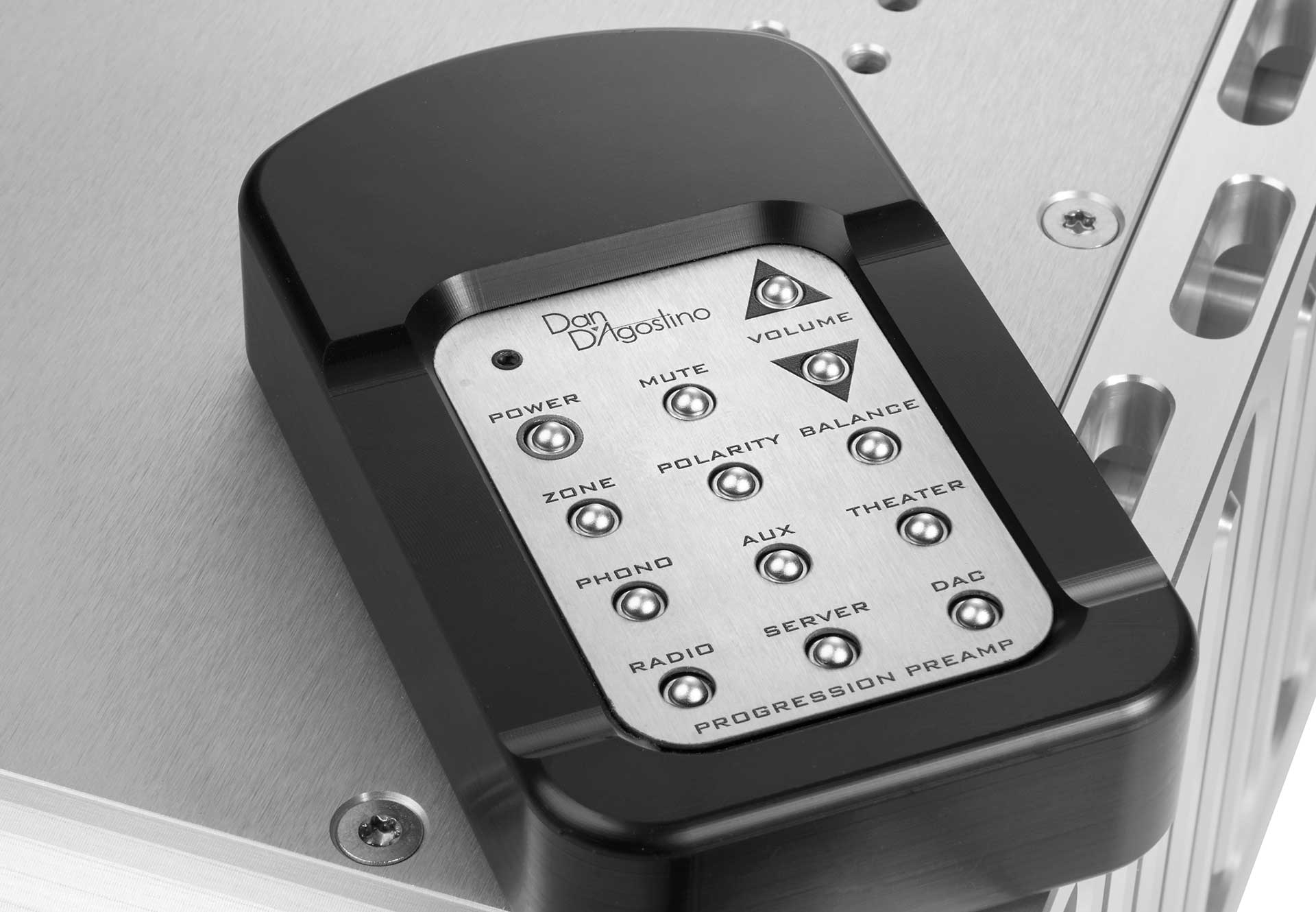
Remote control
The remote control D’Agostino supplies with the Progression Integrated is unusual for at least two reasons. The first is that it looks like no remote control I’ve ever seen before, being almost square, rather than rectangular. The second is that it communicates with the amplifier via Bluetooth radio signals rather than via the more usual infra-red optical signals.
While I am not convinced by the shape of the control, for reasons of both aesthetics and ease-of-use, I am totally on-board with using Bluetooth rather than infra-red, because you don’t need line-of-sight to use it, you don’t need to ‘point’ it at the amplifier, and it operates from a lot further away than a typical IR remote. I was even able to operate the amplifier from a completely different room in my home.
Using a Bluetooth remote is very canny, too, because it makes it possible for users to use their phone or other device to control the Progression integrated via an app instead of using the remote. However it appears that at the time of writing, at least, D’Agostino has only got around to providing an app for IOS devices. As yet, there’s no app available for Android. But there very well could be one by the time you read this review, so that’s something you will need to check for yourself.
The Progression Integrated incorporates D’Agostino’s ‘Super Rail’ technology, where the front end of the amplifier is powered by a fully-regulated high-voltage rail, whereas the output stage’s rail is at a much lower voltage and unregulated. This means that the output stage will always run out of power before the input stage, which D’Agostino says makes the amplifier totally solid, totally stable, and able to drive huge amounts of current into very low impedances without affecting its performance. “Keeping the front-end transistors at a constant voltage irrespective of the output of the amplifier gives you an extra edge on power and big dynamics without the front end being crushed by the output stage,” he says.
As with the Momentum and the Relentless, the Progression uses unusual elliptical heat-sinking. It’s one of the reasons for the amplifier’s good looks, but there’s a practical aspect as well, because D’Agostino took an aversion to conventional heatsink fins after one ripped a hole in his favourite suit; “It was a very expensive Canali suit and it can’t be fixed,” he says. The Progression’s heat-sink finning is actually more efficient than the ones in the Momentum, because the holes are bigger, which gives them more area to dissipate heat.
If you look at the excellent Owner’s Manual provided with the D’Agostino Progression Integrated (it’s also downloadable from D’Agostino’s website, so you could start reading it straight away if you wanted to) you’ll see that it says “Handmade and built by hand in the USA using USA machinists, vendors and parts procurement.”
If that sentence sounded rather specific and long-winded, it’s because D’Agostino is well aware that many manufacturers that claim to build their products in the United States in fact get all the component parts made in foreign countries and merely assemble them in the USA. It’s great to see D’Agostino doing the right thing.
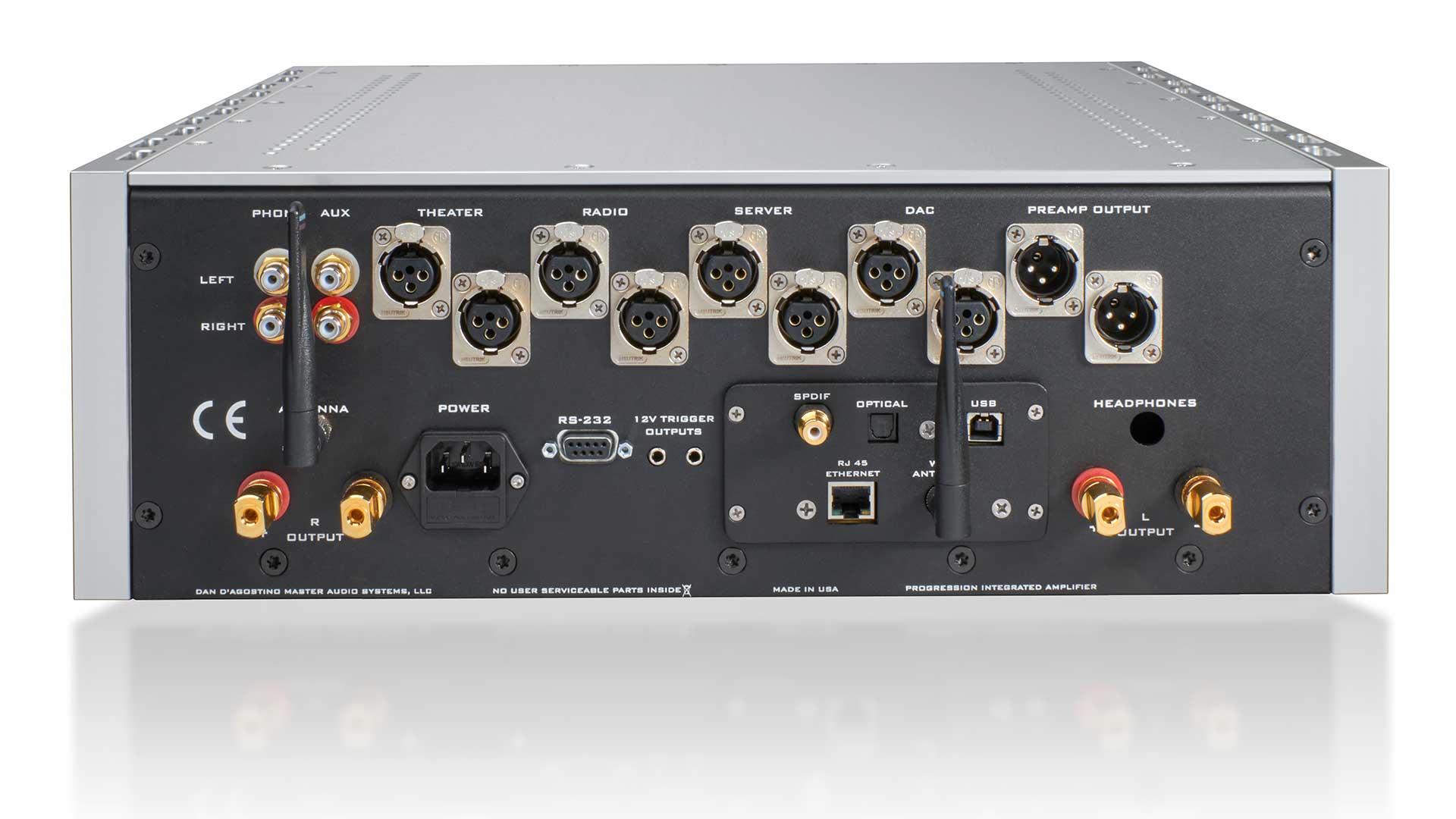
Rear panel connections
Obviously the appearance of the rear panel will vary depending on whether or not you have optioned in the digital module. If you have, you’ll see a bolt-on plate with optical (Toslink) and coaxial (gold-plated RCA) digital inputs, an RJ-45 Ethernet jack, a USB (Type-A) input and a single stubby wi-fi antenna.
If you’ve optioned in the phono module, the gold-plated RCA terminals at the far left of the rear panel alongside the gold-plated RCA terminals marked ‘Aux’ will actually be a phono input, as per the ‘Phono’ lettering screen-printed above them. If you haven’t optioned it in, this will simply be a standard unbalanced line-level input.
As for all the other inputs, every single one of them is balanced, in keeping with the amplifier’s balanced circuitry (the output stage is also balanced). Rather oddly, rather than mounting the eight female gold-plated XLR inputs either horizontally or vertically in the usual manner, D’Agostino has off-set them.
It was only when I actually went to connect cables to them that I realised that although this might look odd, it works really well, because it’s super-easy to insert and remove the XLR connectors, all of which have tiny locking buttons that would otherwise be difficult to access (at least the left-channel ones would be).
As for outputs, you get balanced pre-amplifier outputs (again via XLR, but of course male types this time, rather than female).
Also on the rear panel are a Bluetooth antenna, an RS232 connector to enable control via a home automation system, 12V triggers to enable automatic remote power switching, a 6.35mm headphone socket and, of course, left and right channel speaker terminals (gold-plated multi-way types).
The fact that the D’Agostino Progression’s headphone socket is on the rear panel is interesting. I am guessing that it wasn’t put on the front panel because it would have ruined the obvious visual symmetry of the front panel design. It’s also more cost-effective to put it on the rear panel, rather than the front. If you don’t use headphones, it’s not going to worry you much, but if you do, this position is likely going to be rather inconvenient.
If it is, I’d recommend that you buy a headphone extension lead, plug it into the rear panel socket and run the female end to somewhere more convenient. In order to activate the headphone output you have to press the Theatre button on the front panel and hold it down for three seconds. Activating the headphone output simultaneously deactivates the speaker outputs, so you can’t use both at the same time, which is something I often do. Then, in order to switch the headphone output off, so you can again listen via your speakers, you have to switch the amplifier off (or, more precisely, to Standby) then switch it back on again.
Setting up
Installation is straight-forward, though you do have to be careful connecting speaker wires because the knobs of the gold-plated speaker terminals are not insulated. It is perhaps for this reason that D’Agostino’s Owners’ Manual recommends “the use of high-quality cables terminated with spade or ring lugs that will fit the Progression Integrated amplifier’s binding posts.” (The reason being that any stray wires could result in a short-circuit.)
You also have to make sure that you connect only ordinary, passive loudspeakers to the output terminals. If you connect an active speaker or a subwoofer, there’s a possibility that the negative terminal of that device could be grounded, in which case it might result in damage to the D’Agostino’s balanced output stage.
And for those who like their equipment on the floor, you can only do this with the Progression Integrated if you have a hard wood or tile (or more likely, natural stone) floor. The Owners’ Manual specifically states that the amplifier should not be used on a carpeted surface. As for setting polarity before listening, the simple fact is that you can’t ‘set’ polarity.
You’re very likely to have to use a different setting for each different recording you listen to, because some will come into the amplifier with correct polarity and won’t need to be inverted, whilst others will come in with incorrect polarity and will need to be inverted. Which is why having a switch to do it (rather than re-wiring both your loudspeakers every time, which is the way to invert polarity manually) is a no-brainer.
The bad news is that it’s difficult to choose the polarity that sounds the best, much less the polarity that’s actually correct. But don’t just take my word for it, even D’Appolito’s Owners’ Manual says: “Depending on the recording, the effects of polarity inversion are often subtle and sometimes even inaudible.” I have to say that I do like that the multi-function meters turn from green to red when the polarity is inverted.
The good news is that the D’Appolito Progression Integrated sounds fantastically good, no matter which polarity setting you choose, which is hardly a surprise considering it was designed by a man who’s been building critically-acclaimed, award-winning amplifiers for more than forty years.
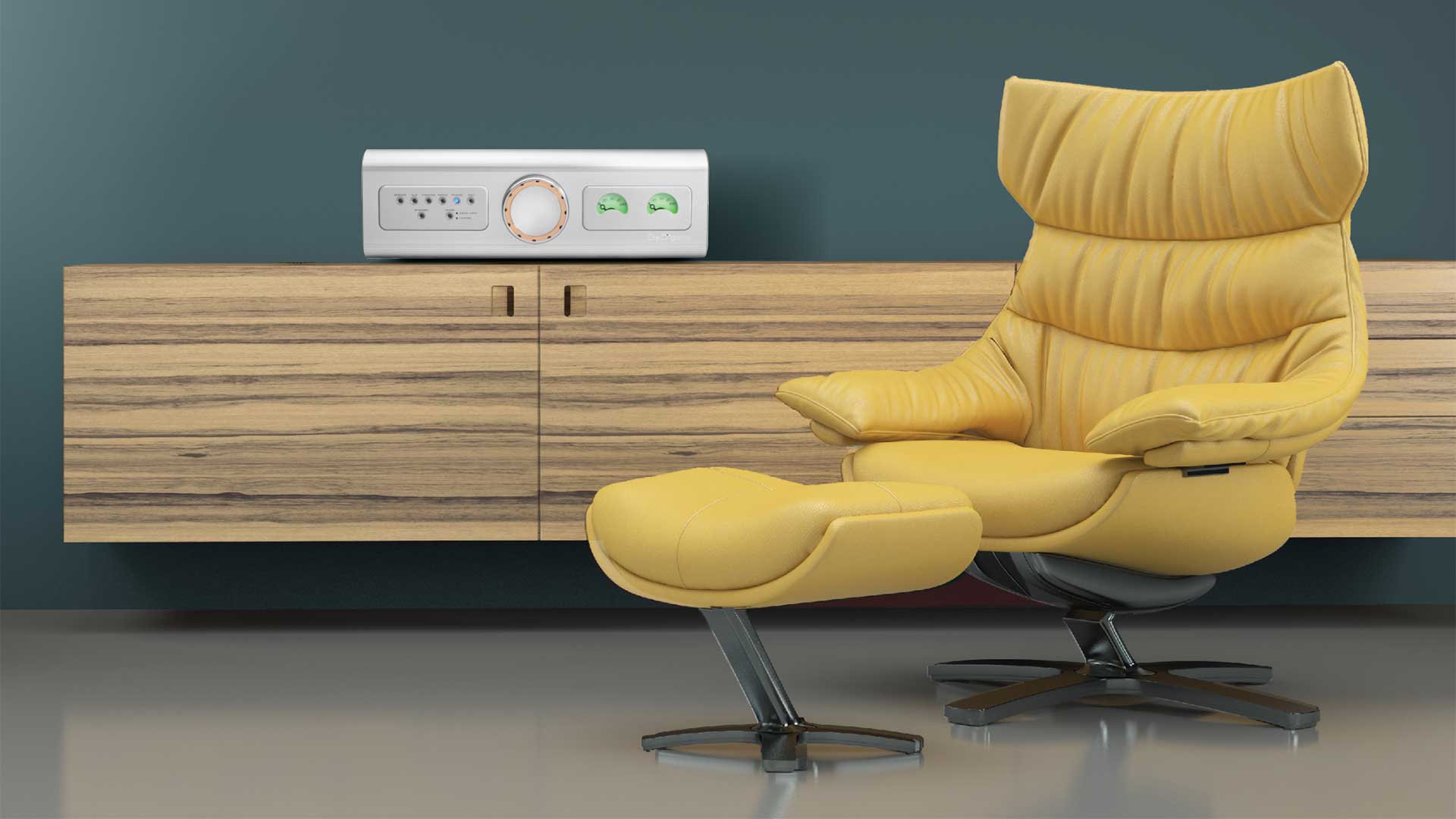
Listening sessions
Sonically, the Progression Integrated doesn’t set a foot wrong. The sound is glorious and there’s plenty of it. The most obvious ‘on-paper’ difference between the Progression Integrated and, say the Progression Stereo – or even the Progression Mono – is the power output, but given the totally clean, undistorted volume levels I was able to achieve in my listening room using very inefficient loudspeakers, I really doubt that there is anything to be gained by adding an additional 100-watts per channel output in the case of the Progression Stereo or even 300-watts in the case of the Progression Mono, other than bragging rights. It’s important to bear in mind that those figures represent audible increases in power output of just 1.7dB and 3.9dB respectively.
Basically, what I’m saying is that unless you have extraordinarily inefficient loudspeakers and have a listening room that’s the size of a concert hall, you really aren’t going to need any more power than is available from the Progression Integrated, that being 200-watts per channel into 8Ω loads and 400-watts per channel into 2Ω loads.
I really tried hard to drive the amplifier into clipping, even resorting to wearing ear-plugs so that I could turn the volume up without damaging my ears, yet I still could not get the Progression’s output stage to clip, even with highly dynamic music that was full of transients. When playing my loudspeakers at levels louder than I’d ever play them, even in my most enthusiastic and raucus listening sessions, the bass from the Progression was ultra-tight, ultra-solid and completely coherent, without any blurring of even the fastest bass passages, and with absolutely no diminution in tonal quality.
At the same time, while this bass was going full tilt, the clarity and transparency of the very highest frequencies was totally unaffected by the goings-on in the bass – for example I could hear not only the reality of an initial cymbal strike, but also the shimmer as the sound faded into inaudibility. In other words, outstandingly good performance.
I’ve been listening to Nick Cave and Warren Ellis’s latest album, Carnage, and it was a revelation to hear it reproduced by the D’agostino Progression. Even the opener, Hand of God, which is fairly undemanding, demonstrated increased rhythmic stability in its underlying pulse.
As for the myriad synthesised sounds, the Progression made it clear that they were synthesised, whereas lesser amplifiers might have you wondering if they were real or synthesised. The motif ‘Hand of God’ which is repeatedly chanted throughout the track by various solo voices, as well as by choirs, all with varying degrees of deliberate distortion, sounded more ethereally authentic when I listened using the Progression.
Is this Cave and Ellis’s best album since Push The Sky Away, or Abattoir Blues? I’d say not, and it’s not even up to the standard of Ghosteen, but it’s a fine album indeed, and it’s certainly wonderfully recorded.
I admit to being adversely affected in my opinion by how down-beat all the tracks are, despite some of the inspired lyrics, witness “Reading Flannery O’Connor with a pencil and a plan” from the title track, or, even better, from the album’s best track, Albuquerque, “We won’t get to anywhere, darling, any time this year / We won’t get to anywhere / Unless I dream you there” but I guess I should not have expected anything uplifting from an album that’s titled Carnage. Cave and Ellis certainly deliver what they promise. I would dearly love it if they’d re-record this album with real instruments.
Carnage is so depressing that I felt almost uplifted playing one of my current favourite albums, which is kind of on daily rotation, that being the album Promises, by Pharoah Sanders and Floating Points (the stage name of pianist and DJ Sam Shepherd) in collaboration with the London Symphony Orchestra. At 75 years of age his signature saxophone sound is not what it once was, but he accommodates the deficiencies so well, in the process creating mesmerising soundscapes, particularly against the sustained sounds created by the LSO’s string section.
Once again, the D’Agostino Progression reveals instantly that you’re listening to real strings, rather than samples. The Progression also captures the melancholy of the Sanders’ sax dramatically well, especially in its lower registers, while also being rather more revealing of the reed sounds than lesser amplifiers. It’s also rather revealing of the sounds at the end of Movement 2, and those at the beginning of Movement 3, but amplifiers are supposed to reveal such minutiae, irrespective of whether they’re supposed be there or not.
For fans who’ve been waiting patiently for nigh-on seven years, don’t think twice before picking up a copy of The Antlers’ (Peter Silberman and Michael Lerner) Green to Gold album. I get distracted every time I play the second track, Wheels Roll Home, whose melody and arrangement reminds me of Tommy James & The Shondells’ 60s hit Crimson and Clover (covered more recently by artists as diverse as Joan Jett, Cher, Dolly Parton and Prince), but that certainly doesn’t stop me playing Green To Gold over and over.
It’s just such a lovely, quiet, contemplative album all of whose tracks resonated with me, particularly Just One Sec on which Silberman laments “Could you clear my cache momentarily? / For just one sec, free me from me.” I think I’d play this album even if it wasn’t a great recording, but luckily it is, as you’ll hear if you use the D’Agostino Progression to play it, for example the drum sound on Stubborn Man and the gorgeous bass and lead guitar sound on the title track (and the drums too). Laid over all is the mellifluous vocal of Silberman himself.
Great acoustic guitar intro to Porchlight too, with the brushed drums and the lovely atmospherics. The out-of-tune piano sound is a nice touch as well.
Switching to something with a bit more bite, I played Foo Fighters’ latest, Medicine at Midnight. As Arlo Guthrie famously said in one of his songs ‘it wasn’t the best song I ever wrote’ and Dave Grohl might be the first to admit that it isn’t the best album they’ve ever released. The metal isn’t that heavy and there’s a noticeable lack of the energy that permeated All My Life, for example. The tracks are also a little too formulaic for my liking, with six tracks clocking in within 9 seconds of each other. Co-incidence?
Still, there’s a lot to enjoy, again both musically and sonically, most especially when you have amplification of the quality of the D’Agostino Progression Integrated. Listen carefully and you’ll hear how the Progression has perfect balance between its two channels, plus you can actually hear the separation between the tracks during the multi-tracking, such as on Shame Shame and even more evidently on the intro to Cloudspotter, where you should hear total silence in the right channel during the guitar riff until the percussion starts in the right.
I happened to be looking at the D’Agostino’s meters at the time and noticed that the right channel’s meter was dancing even though it was the left channel that was playing. I assumed this was a one-off on my review sample, and it’s easily fixed in any case.
More great sound from Australian trio Middle Kids’ new album Today We’re the Greatest. It’s the first they’ve made in a top pro studio and trust me, you can hear the difference! What hasn’t changed is the fabulous voice of lead singer Hannah Joy, except that you can now hear it in all its glory.
This is no better examplared that on Cellophane (Brain) which starts off acoustic then bursts into electric guitar heaven with Joy’s voice leaping high and low in front and behind. The kick-ass bass on R U 4 me let me forgive the song’s title, Stacking Chairs is a masterpiece of a tune and Questions had me gasping for breath. Golden Star has everything and more, all revealed with amazing clarity by the D’Agostino Progression. But all the tracks really work up to the closer Today We’re The Greatest which is a truly glorious song on all levels.
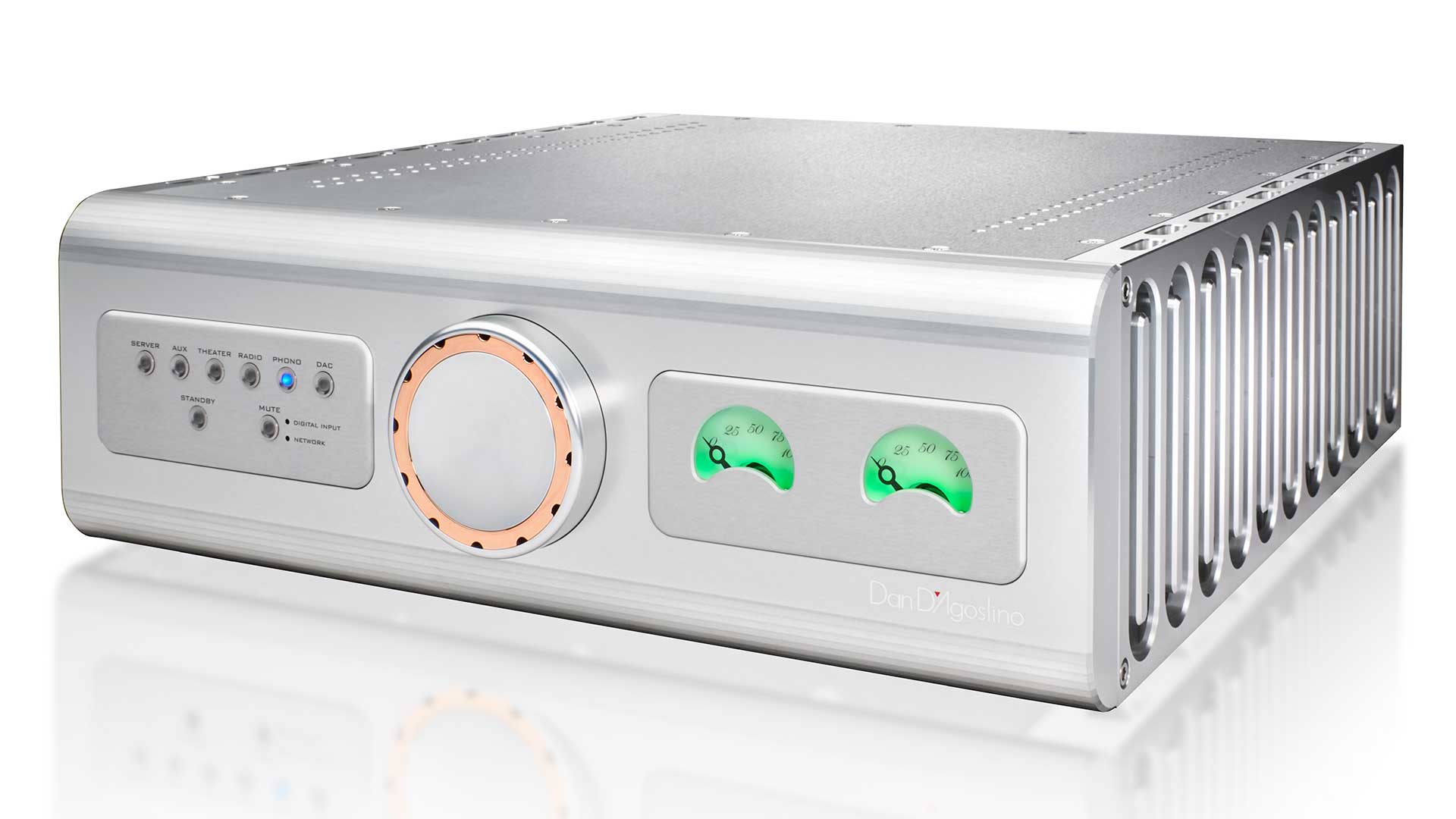
Verdict
This latest addition to Daniel D’Agostino’s Progression series of components can be tailored to suit your exact requirements. But the greatest thing about this new amplifier is that it delivers the performance you’d expect from, say, the equivalent model in D’Agostino’s Momentum series at just a fraction of the price. In other words, it’s everything you need in a high-end audio amplifier.
Australian Hi-Fi is one of What Hi-Fi?’s sister titles from Down Under and Australia’s longest-running and most successful hi-fi magazines, having been in continuous publication since 1969. Now edited by What Hi-Fi?'s Becky Roberts, every issue is packed with authoritative reviews of hi-fi equipment ranging from portables to state-of-the-art audiophile systems (and everything in between), information on new product launches, and ‘how-to’ articles to help you get the best quality sound for your home.
Click here for more information about Australian Hi-Fi, including links to buy individual digital editions and details on how best to subscribe.

